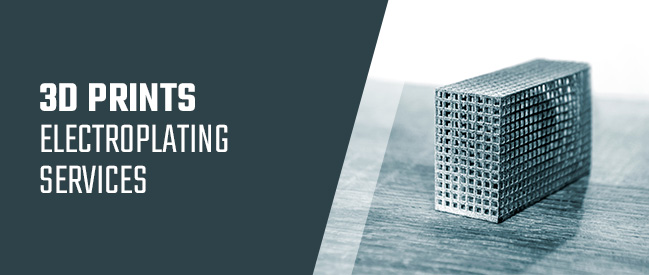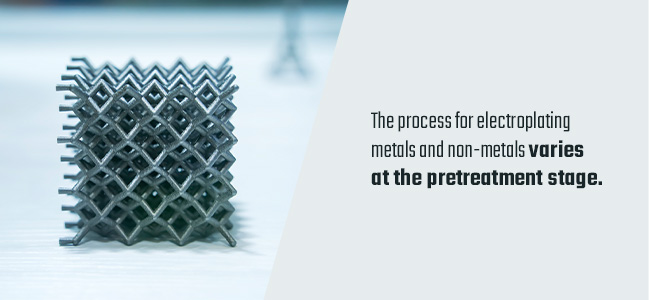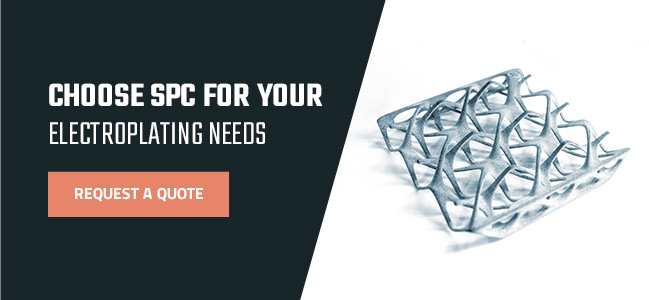Request a free quote
For 3D Print Plating

In recent years, 3D printing has experienced rapid expansion across multiple industries, finding overwhelming application in the manufacture of products such as hearing aids, dental appliances and aircraft parts.1 Many of these industries rely on electroplating to infuse unique metal qualities to parts and products, enhancing features like functionality and aesthetics.
As a leader in electroplating services, SPC offers advanced metal finishing solutions to match your specific applications. Learn about our electroplating services for 3D prints and how 3D printed items are prepared and plated below.2
Why Electroplating Is Essential for 3D-Printed Parts
Electroplating is an effective solution for enhancing 3D printed parts due to its many benefits. While metal 3D prints exist and eliminate the need for additional finishing, they are cost-prohibitive, making large-scale industrial or commercial productions less practical.3 Low-cost printing processes using less expensive materials and electroplating offer a reliable and practical alternative.
1. Increases Durability
Many people working with 3D prints seek electroplating services for additive manufacturing to improve the mechanical properties of their printed materials. Polymers like plastic, for example, lack the strength and durability that metal offers.
SPC's electroplating services reinforce these polymers with a metallic layer, significantly increasing the material's strength and wear resistance, making it more robust and durable. These enhancements add qualities to 3D printed materials that allow greater resilience, potentially expanding their applications.
2. Improves Conductivity
Metals with high electrical conductivity are also high in thermal conductivity. For less conductive metals, electroplating offers a solution that increases conductivity and performance in specific applications. While aluminum and brass are less conductive, they are more cost-effective. By plating them in silver or copper — some of the most conductive metals on Earth — you increase the conductivity of the previous metals.4
Aside from metal, you can plate onto plastics, which are nonconductive materials that make their surfaces conductive.5 Plastics offer the qualities of metals without incurring their expenses. However, non-metals pose unique challenges when it comes to electroplating due to their chemical composition.6
Regardless of the challenges posed by low surface energy substrates, SPC utilizes effective processes to apply conductive layers of metals like silver and copper to improve the electrical and thermal performance of the printed material.
3. Enhances Corrosion Resistance
One of the top benefits of electroplating is its ability to enhance corrosion and wear resistance in materials. Our plating technologies coat the material with a barrier layer that protects the component from corrosion. The result is a reliable reinforcement that helps printed materials withstand harsh environments longer.
4. Provides Temperature Resistance
Plastics and other materials with low heat resistance can benefit from electroplating. Metals with extremely high melting points, such as stainless steel and nickel, are excellent for plating materials with less resistance to high temperatures because they increase the substrate's ability to withstand heat complications like deformities.
The Electroplating Process for 3D-Printed Items

While most 3D prints involve non-metals, metals can also be used.7 The process for electroplating metals and non-metals varies at the pretreatment stage. Non-metals require extensive pretreatment to overcome challenges like proper adhesion.
Below is a breakdown of the initial requirements for both materials before the plating process. Note that the final electroplating process is similar for metal and non-metal 3D prints.
Pretreatment for Metal Substrates
For metal substrates, SPC offers advanced cleaning and activation methods to remove contaminants and oxides, which prepare the surface for proper adhesion. Cleaning methods vary from mechanical to chemical polishing. Afterward, electroplating can occur, as the metals are already conductive and support the flow of currents.
Pretreatment for Non-Metal Substrates
Non-metals are insulating materials, meaning they prevent the flow of electric current between the anode and cathode.8 In this case, the anode is the plating metal while the cathode is the substrate. The pretreatment process generally involves:
- Surface preparation: The non-metal substrate is cleaned to remove dirt and contaminants. The next step is chemical etching, where the substrate is dipped into an etching solution to improve adhesion.
- Conductive layer: The key difference between electroplating a metal and a non-metal substrate is the creation of a conductive layer. SPC relies on precision surface treatments, applying conductive layers like copper or nickel to prepare the substrate for successful metal deposition.
The Final Electroplating Process
Here is a breakdown of the electroplating process for 3D-printed items:
- Prepare the plating setup: The setup involves an electroplating bath, which is a tank or container filled with the appropriate electrolyte solution. Then, the plating metal and substrate, or the 3D print, are prepared. A direct current power source and electrical connections are required to power the chemical reaction.
- Immerse the substrate: The electrical circuit is completed by attaching the anode to the plating metal and the cathode to the substrate. The materials are then submerged in the electrolyte bath.
- Complete the plating process: The required current is calculated based on tank volume, substrate thickness and surface area. Excess current causes uneven coating, while weak current leads to inadequate metal deposition.
Due to the complexity and precision involved, it is best to seek professional electroplating 3D prints services.
Discover SPC's Expertise in Electroplating 3D Prints
SPC has extensive expertise in additive manufacturing electroplating services, offering specialized solutions to enhance quality and functionality. We serve a variety of businesses in numerous sectors, from aerospace and automotive to oil and gas. As an ISO-certified company, the SPC team prioritizes safety, reliability and high quality, displayed in our 3D electroplating services and beyond.
- Metal compatibility: We excel in electroplating diverse 3D-printed materials such as ABS, polycarbonate and resins, which we plate with metals that provide the strongest and most reliable performance. We work with a range of metals, such as gold, nickel and silver.9
- Custom coating: We provide tailored coating solutions to meet your specific needs. For example, you can decide whether you need corrosion resistance or electrical conductivity.
- Specialized plating: SPC offers a diverse range of 3D print plating services, from prototype development to production runs. We have the capacity to ensure consistency for your industrial project.
Choose SPC for Your Electroplating Needs
At SPC, we have set ourselves apart as a full-service coating company driven by innovation and offering cutting-edge solutions, including additive manufacturing electroplating services. For over 90 years, SPC has remained committed to innovative approaches, which have kept us at the forefront of metal finishing technologies. We complete surface finishing for all types of 3D prints across multiple industries, ensuring quality and precision.10
Finding a solution that matches your company's needs can be challenging. SPC simplifies this process when you choose our reliable electroplating services — we offer comprehensive consulting services to help you select the solution that best suits your needs. Get started today with a free quote.11 You can also request a consultation to learn more about our company and processes and discover why we're the ideal partner.12
Endnotes:
- https://www.theguardian.com/technology/2023/mar/12/3d-printing-the-new-technology-comes-into-its-own
- https://www.sharrettsplating.com/plating-methods/
- https://www.mdpi.com/2504-4494/8/2/44
- https://onlinelibrary.wiley.com/doi/10.1002/pssa.202000704
- https://www.sharrettsplating.com/base-materials/plastics
- https://depts.washington.edu/matseed/batteries/MSE/components.html
- https://pmc.ncbi.nlm.nih.gov/articles/PMC10255598/
- https://www.sharrettsplating.com/coatings/
- https://www.sharrettsplating.com/industries/
- https://www.sharrettsplating.com/blog/density-affects-plating-plastic-parts/
- https://www.sharrettsplating.com/free-quote.php
- https://www.sharrettsplating.com/additional-services/consulting.php
LEARN WHAT OUR MANY SATISFIED CUSTOMERS HAVE TO SAY ABOUT Us
"I would like to thank you for the help you have provided us in developing an electroless nickel plating technique on an unusual substrate. The sample platings you provided show that we should be able to reach our goals. I especially appreciate your willingness to take on an unusual job, with the uncertainties that that entails...We are looking forward to working with you in the future on our plating needs."
– Robert K.




